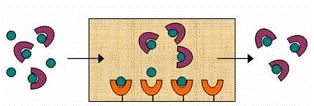Department of Chemistry
Document Type
Article
Date of this Version
1992
Citation
CLINICAL CHEMISTRY, Vol.38, No.8, 1992, pp. 1494-1500.
Abstract
The performance and clinical utility of an automated assay of intact parathyroid hormone (parathyrin, PTH) are evaluated. The method is based on the extraction of PTH from plasma by an HPLC column containing immobilized anti-(44-68 PTH) antibodies. The PTH retained is detected with a postcolumn reactor and use of anti-(1--34 PTH) chemiluminescent-labeled antibodies. The total cycle time of the assay is 6.5 mm per injection after a 1-h incubation.The lower limit of detection for PTH in a 66-pL plasma sample was 0.5 pmol/L based on peak heights and 0.2 pmol/L based on peak areas. Mean analytical recovery for PTH added to plasma was 97%. The withinday precisions (CVs) for 4.2 and 30 pmol/L PTH plasma samples were 9.2% and 5.6% and the day-to-day precisions were 10.3% and 5.7%, respectively. No significant interferences from 1-34,44-68, or 53-84 PTH fragments were noted, even at highly increased concentrations of fragments. The correlation of results with those of a manual assay of intact PTH was 0.97, and the results showed good agreement with disease state for patients with hypo- or hyperparathyroidism. The specificity of the assay for primary hyperparathyroldism was >95%. We discuss the advantages (speed and quality control) of this approach over current immunoassays and the potential use of this method for detecting other analytes.
Included in
Analytical, Diagnostic and Therapeutic Techniques and Equipment Commons, Biochemistry, Biophysics, and Structural Biology Commons, Chemicals and Drugs Commons, Medicinal-Pharmaceutical Chemistry Commons



Comments
Copyright (c) 1992 American Association for Clinical Chemistry.